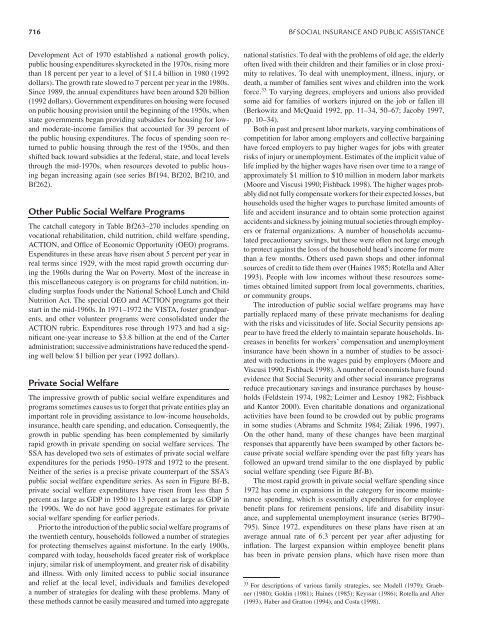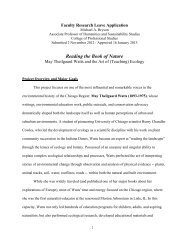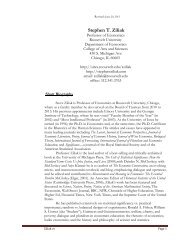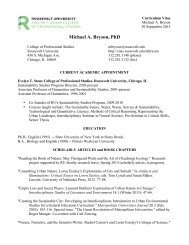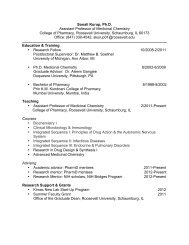Social Insurance and Public Assistance
public-assistance-welfare-reform-colonial-times-to-the-present-ziliak ...
public-assistance-welfare-reform-colonial-times-to-the-present-ziliak ...
Create successful ePaper yourself
Turn your PDF publications into a flip-book with our unique Google optimized e-Paper software.
716 Bf SOCIAL INSURANCE AND PUBLIC ASSISTANCE<br />
Development Act of 1970 established a national growth policy,<br />
public housing expenditures skyrocketed in the 1970s, rising more<br />
than 18 percent per year to a level of $11.4 billion in 1980 (1992<br />
dollars). The growth rate slowed to 7 percent per year in the 1980s.<br />
Since 1989, the annual expenditures have been around $20 billion<br />
(1992 dollars). Government expenditures on housing were focused<br />
on public housing provision until the beginning of the 1950s, when<br />
state governments began providing subsidies for housing for low<strong>and</strong><br />
moderate-income families that accounted for 39 percent of<br />
the public housing expenditures. The focus of spending soon returned<br />
to public housing through the rest of the 1950s, <strong>and</strong> then<br />
shifted back toward subsidies at the federal, state, <strong>and</strong> local levels<br />
through the mid-1970s, when resources devoted to public housing<br />
began increasing again (see series Bf194, Bf202, Bf210, <strong>and</strong><br />
Bf262).<br />
Other <strong>Public</strong> <strong>Social</strong> Welfare Programs<br />
The catchall category in Table Bf263–270 includes spending on<br />
vocational rehabilitation, child nutrition, child welfare spending,<br />
ACTION, <strong>and</strong> Office of Economic Opportunity (OEO) programs.<br />
Expenditures in these areas have risen about 5 percent per year in<br />
real terms since 1929, with the most rapid growth occurring during<br />
the 1960s during the War on Poverty. Most of the increase in<br />
this miscellaneous category is on programs for child nutrition, including<br />
surplus foods under the National School Lunch <strong>and</strong> Child<br />
Nutrition Act. The special OEO <strong>and</strong> ACTION programs got their<br />
start in the mid-1960s. In 1971–1972 the VISTA, foster gr<strong>and</strong>parents,<br />
<strong>and</strong> other volunteer programs were consolidated under the<br />
ACTION rubric. Expenditures rose through 1973 <strong>and</strong> had a significant<br />
one-year increase to $3.8 billion at the end of the Carter<br />
administration; successive administrations have reduced the spending<br />
well below $1 billion per year (1992 dollars).<br />
Private <strong>Social</strong> Welfare<br />
The impressive growth of public social welfare expenditures <strong>and</strong><br />
programs sometimes causes us to forget that private entities play an<br />
important role in providing assistance to low-income households,<br />
insurance, health care spending, <strong>and</strong> education. Consequently, the<br />
growth in public spending has been complemented by similarly<br />
rapid growth in private spending on social welfare services. The<br />
SSA has developed two sets of estimates of private social welfare<br />
expenditures for the periods 1950–1978 <strong>and</strong> 1972 to the present.<br />
Neither of the series is a precise private counterpart of the SSA’s<br />
public social welfare expenditure series. As seen in Figure Bf-B,<br />
private social welfare expenditures have risen from less than 5<br />
percent as large as GDP in 1950 to 13 percent as large as GDP in<br />
the 1990s. We do not have good aggregate estimates for private<br />
social welfare spending for earlier periods.<br />
Prior to the introduction of the public social welfare programs of<br />
the twentieth century, households followed a number of strategies<br />
for protecting themselves against misfortune. In the early 1900s,<br />
compared with today, households faced greater risk of workplace<br />
injury, similar risk of unemployment, <strong>and</strong> greater risk of disability<br />
<strong>and</strong> illness. With only limited access to public social insurance<br />
<strong>and</strong> relief at the local level, individuals <strong>and</strong> families developed<br />
a number of strategies for dealing with these problems. Many of<br />
these methods cannot be easily measured <strong>and</strong> turned into aggregate<br />
national statistics. To deal with the problems of old age, the elderly<br />
often lived with their children <strong>and</strong> their families or in close proximity<br />
to relatives. To deal with unemployment, illness, injury, or<br />
death, a number of families sent wives <strong>and</strong> children into the work<br />
force. 33 To varying degrees, employers <strong>and</strong> unions also provided<br />
some aid for families of workers injured on the job or fallen ill<br />
(Berkowitz <strong>and</strong> McQuaid 1992, pp. 11–34, 50–67; Jacoby 1997,<br />
pp. 10–34).<br />
Both in past <strong>and</strong> present labor markets, varying combinations of<br />
competition for labor among employers <strong>and</strong> collective bargaining<br />
have forced employers to pay higher wages for jobs with greater<br />
risks of injury or unemployment. Estimates of the implicit value of<br />
life implied by the higher wages have risen over time to a range of<br />
approximately $1 million to $10 million in modern labor markets<br />
(Moore <strong>and</strong> Viscusi 1990; Fishback 1998). The higher wages probably<br />
did not fully compensate workers for their expected losses, but<br />
households used the higher wages to purchase limited amounts of<br />
life <strong>and</strong> accident insurance <strong>and</strong> to obtain some protection against<br />
accidents <strong>and</strong> sickness by joining mutual societies through employers<br />
or fraternal organizations. A number of households accumulated<br />
precautionary savings, but these were often not large enough<br />
to protect against the loss of the household head’s income for more<br />
than a few months. Others used pawn shops <strong>and</strong> other informal<br />
sources of credit to tide them over (Haines 1985; Rotella <strong>and</strong> Alter<br />
1993). People with low incomes without these resources sometimes<br />
obtained limited support from local governments, charities,<br />
or community groups.<br />
The introduction of public social welfare programs may have<br />
partially replaced many of these private mechanisms for dealing<br />
with the risks <strong>and</strong> vicissitudes of life. <strong>Social</strong> Security pensions appear<br />
to have freed the elderly to maintain separate households. Increases<br />
in benefits for workers’ compensation <strong>and</strong> unemployment<br />
insurance have been shown in a number of studies to be associated<br />
with reductions in the wages paid by employers (Moore <strong>and</strong><br />
Viscusi 1990; Fishback 1998). A number of economists have found<br />
evidence that <strong>Social</strong> Security <strong>and</strong> other social insurance programs<br />
reduce precautionary savings <strong>and</strong> insurance purchases by households<br />
(Feldstein 1974, 1982; Leimer <strong>and</strong> Lesnoy 1982; Fishback<br />
<strong>and</strong> Kantor 2000). Even charitable donations <strong>and</strong> organizational<br />
activities have been found to be crowded out by public programs<br />
in some studies (Abrams <strong>and</strong> Schmitz 1984; Ziliak 1996, 1997).<br />
On the other h<strong>and</strong>, many of these changes have been marginal<br />
responses that apparently have been swamped by other factors because<br />
private social welfare spending over the past fifty years has<br />
followed an upward trend similar to the one displayed by public<br />
social welfare spending (see Figure Bf-B).<br />
The most rapid growth in private social welfare spending since<br />
1972 has come in expansions in the category for income maintenance<br />
spending, which is essentially expenditures for employee<br />
benefit plans for retirement pensions, life <strong>and</strong> disability insurance,<br />
<strong>and</strong> supplemental unemployment insurance (series Bf790–<br />
795). Since 1972, expenditures on these plans have risen at an<br />
average annual rate of 6.3 percent per year after adjusting for<br />
inflation. The largest expansion within employee benefit plans<br />
has been in private pension plans, which have risen more than<br />
33 For descriptions of various family strategies, see Modell (1979); Graebner<br />
(1980); Goldin (1981); Haines (1985); Keyssar (1986); Rotella <strong>and</strong> Alter<br />
(1993), Haber <strong>and</strong> Gratton (1994), <strong>and</strong> Costa (1998).


